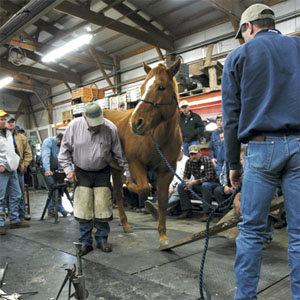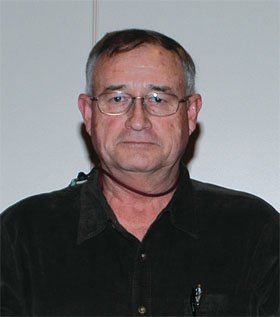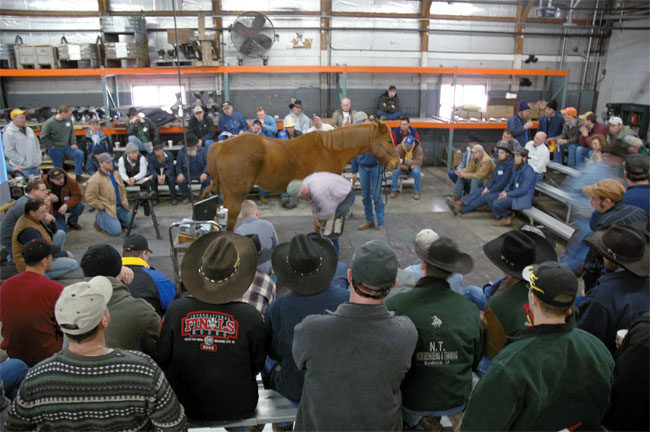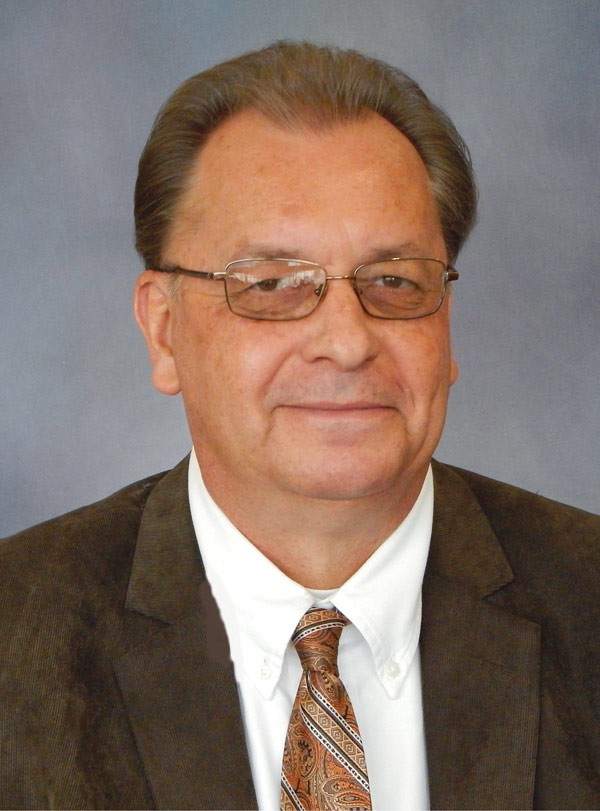A crowd of farriers was on hand at a clinic at Anvil Brand to learn from Hall Of Fame horseshoer Jim Keith, who has unusual views on hoof balance.
“It’s called horseshoeing, not footshoeing,” says Jim Keith, explaining why he rejects the traditional approach of aligning the hoof-pastern axis as the starting point for bringing a hoof into balance.
Keith of Tucumcari, N.M., a member of the International Horseshoeing Hall Of Fame and a former, two-time American Farrier’s Association Educator of the Year, notes that there are widely varying opinions about what proper balance really is, which leaves many farriers confused and unsure about what’s right.
Appearing as the instructor at a recent shoeing clinic staged by Anvil Brand in Lexington, Ill., Keith said that rather than focusing on the pastern alignment, farriers should look at the whole horse and then trim the hooves to help the horse “stand on” its feet, placing the horse’s center of gravity directly over the hooves. By this method, a plumb line dropped from the horse’s shoulder would exit the hoof at the breakover point, he explains.
The Compensation Factor
But if his idea of balance stops there, he concedes, “Basically, every horse standing up is in balance.” So, Keith extends his definition of balance to include hoof care that “creates the least need for compensation” by the hoof to accommodate the horse’s activities.
“Horses compensate for everything that happens to them,” Keith says. He adds, “Compensation — I’ve been using that term for 37 years — means to counterbalance or make up for.” He says an unbalanced hoof might reveal itself in any number of ways, including:
- A stance or gait change.
- Wall distortions.
- Proximal wall displacement (also called jamming).
- Flares.
- Bone remodeling.
- Developmental conformation changes if structural inadequacies exist.
Range-Ready Hooves
Keith’s ideas are shaped by his experience. He has been caring for hooves for more than 50 years, originally in the mesa country of eastern New Mexico, where, he says, horse pastures might measure 10 by 9 miles. Horses there develop very natural feet because they are 3 or 4 years old before being handled, he says, except when they are gelded at age 2.

Hall Of Fame farrier Jim Keith tests the soreness of a horse with chronic foot problems during a recent shoeing clinic at Anvil Brand.
Most of the horses on the mesa usually do not need trimming due to the rocky ground that wears away excess horn, though some develop a “hangnail” on the outside quarters that needs trimming, he says. Virtually every one of these horses that he has worked on was sound and had adapted to the rocky environment.
But environments vary widely, so, he says, “It’s an elusive thing to determine what a natural foot is.” For example, in contrast to the horses on the mesa, horses on sandy soils develop large, wide feet for support, he notes.
Those early observations continue to influence his work of the last three decades, which consists of salvaging working horses with various hoof and limb ailments and extending their useful life spans.
Since the mid-1980s, Keith has traveled extensively worldwide, observing horses in various habitats and working with many good farriers.
The variability in environments means it’s not practical for farriers to try to trim to some standard idea of a “natural” hoof, because natural will differ from place to place, he says.
Compensation And Consequences
Keith defines compensatory conformation as changes to conformation during a horse’s growth to accommodate abnormalities in the upper limb. Such changes are most often manifested in the fetlock or lower limb. However, many farriers focus on the pastern, which can be misleading, he says, because the pastern bones frequently do not align with the center axis of the limb, which he believes should be the starting point for achieving hoof balance.
“There are lots of zigzag developments that end up on the center axis of the limb, and they are functional,” he says. So, he warns farriers, “Don’t try to fix the bones on mature horses. Instead, shoe them so the horse has the least need to compensate.”
A medial-lateral imbalance can create numerous consequences, Keith says, including a base-wide, toe-out stance; stress on the hoof wall; wall distortion; and increased severity of secondary impact, with primary impact being the landing of the heel and secondary impact being the rest of the foot landing just before loading and lift off.
Keith notes that a normal hoof landing is slightly heel first. The more pronounced the heel-first landing, also known as the angle of attack, the greater the secondary impact, he says. Other factors influencing the severity of the impact are the weight of the horse, rider and tack, as well as the momentum of the horse and rider, he notes.
In some cases, trimming the hoof to even out the coronary band can increase the angle of attack and thus increase the secondary impact, he says.
Damage Potential
The greater impact creates potential for toe damage, with a lateral heel impact possibly leading to medial toe damage. “If you’re not seeing hoof cracks, the horse is good at compensating, or you’re doing a pretty good job” of farriery, he says.
Other consequences of overcompensation include interference, overreaching or other stride problems; decreased athletic performance; a shortened useful life span; bone remodeling and proximal displacement of the coronary band in the quarters, according to Keith.
He notes that in forelimb loading, the medial aspect of the forelimbs support most of the weight on the front feet and there is a compensatory response to the extra load resulting in frequent jamming of the medial coronary band. Although jamming is more visible on the lateral side of the foot, he says, it most often occurs on the medial side of the front foot.
In relation to the centerline of the forelimb, the hoof often will be high laterally, Keith says. Being moderately unlevel is of little consequence, he adds, but the greater the compensation required, the more potential for harm to the hoof and limb.
Cracks Don’t Just Happen
“Hooves don’t just spontaneously break open,” he says. Rather, the crack is compensation for abnormal pressure within a hoof, and quarter cracks usually result from a medial-lateral imbalance, he adds.
Often, a farrier’s first reaction is to treat the crack, he says, “But that’s like giving cough syrup to a person dying of pneumonia; you’re only treating the symptom.” While the symptoms should be treated, he says, “What you really have to do is treat the underlying cause.”
As an aside, Keith notes that his hoof care might include a heart bar, but he admits that he sometimes uses one for a placebo effect — on the owners, not the horses. “If they bring a horse 200 miles and I don’t do something magical, they’ll think they’ve been robbed,” he warns.
Discussing potential heel damage, Keith says that for horses in his New Mexico environment, he rarely extends a shoe behind the foot for heel support. He also notes that horses provided “cowboy shoeing” on the vast pastures of the West were often short shod because the farriers worked with keg shoes and did not have anvils at their disposal. “I never saw that lead to corns, despite its reputation,” Keith says, but he quickly adds that he doesn’t advocate short shoeing.
Bones might quickly remodel to compensate for an out-of-balance hoof, according to Keith, as when a weight-bearing surface develops at the tip (or solar margin) of the pedal bones.
Seeking Balance
The solution to compensation problems often starts with the trim, Keith says. After imagining a plumb line from the shoulder indicating a natural breakover point for the hoof, he trims and shoes for the shape of each foot and the direction of travel. However, he cautions that hoof balance can change for any particular horse, especially if the horse’s situation changes, as when it moves from a hard pasture to the soft ground of a show arena, for example.

Jim Keith doesn't “promote” long toes, but he believes that toe length and breakover are commonly overemphasized as factors in lameness.
As a rule, Keith likes to see the solar plane of P3 close to parallel to the ground. “The majority of sound horses have feet like this,” he says. He describes the parallel alignment as the most important aspect of hoof balance, and he becomes concerned when the solar plane of the bone is more than 3 degrees from parallel.
Keith also notes that most horses are better able to accommodate an anterior-posterior imbalance than a medial-lateral imbalance. That’s because the joints have greater freedom of movement from front to back than side to side, just like human feet, he says. In addition, he notes that a medial-lateral imbalance can be damaging to the foot in all phases of weight bearing, while an anterior-posterior imbalance is most likely to cause harm during hard work or motion. So it is logical, he says, to focus on medial-lateral balance when trimming and shoeing.
T-Square Useful
Keith cautions farriers about assessing hooves. “Your eyes will lie to you quite frequently,” he says. “Do we see what’s really happening or what we think is happening?”
He supports the use of a T-square for evaluating medial-lateral balance and adds, “It’s a good way to train your eyes.” He says a T-square, properly used, provides reliable, objective results, puts the focus on the hoof plane rather than the pastern and conforms to the solar plane and sole depth evaluation methods.
On the down side, he notes, a T-square must be accurately oriented with the center axis of the limb, will not work if the cannon bone is misaligned with the center axis, is not universally accepted and is easily misread. “You can make it read whatever you want it to,” he warns.
He offers tips for properly using a T-square. Hold the leg by the cannon bone, he recommends, and keep your elbow inside the horse’s elbow while laying the tool on the leg. Don’t look at the base of the foot first, he adds. Instead, align the long shaft of the T-square with the cannon bone, then slide it up the bone to bring the shorter cross-member up to the sole for an accurate reading, he says.
Anterior-Posterior Balance
Keith looks at several factors when evaluating the anterior-posterior balance of a hoof, including the plane of the sole and of the frog, if it is not diseased; the attitude of the horse; and hoof proportions, including the coronary band.
On many horses, he says the measurement of the heel should be from 33% to 38% of the toe measurement, with the average heel measurement on a sound hoof being 35% of the toe. That means if the toe measures 3 inches, the heel should measure about 1 1/8 inch, he says. To measure the heels accurately, you must push the tape into the bulbs and follow the horn tubules along the slope of the heel, he says. He offers a word of caution, though. Some breeds or bloodlines may have a “deeper foot” and require more length. It is difficult to find one method of evaluation that serves all individuals well.
Keith says he does not promote long toes, but he believes toe length and breakover are commonly overemphasized as factors in lameness.
Although Keith’s views on hoof balance run contrary to those commonly practiced by many hoof care professionals, he warns that many of the current problems he sees develop because of prior farriery work that attempts to make a horse conform to unrealistic notions of “balance and beauty.”









Post a comment
Report Abusive Comment